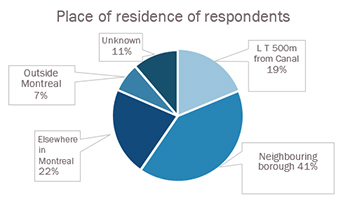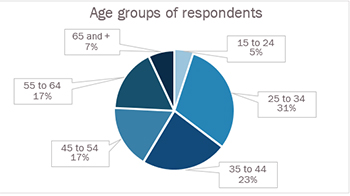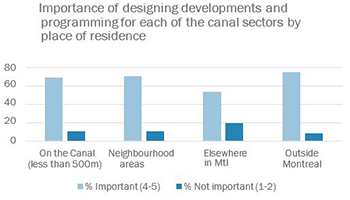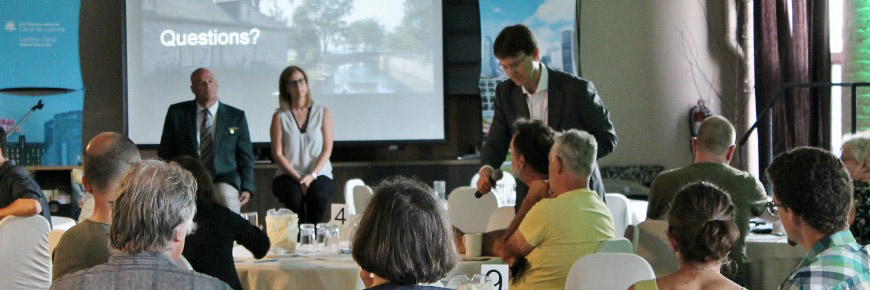
Consultation on the draft management plan for the Lachine Canal
Lachine Canal National Historic Site
Report of the consultation on the draft management plan for the Lachine Canal National Historic Site
Prepared bu Hill+Knowlton Stratégies
The report is also available in PDF. (780 Ko)
Table of content
- Context
1.1. H+K Strategies’ mandate
-
Consultation process
2.1. consultation activities
2.2. Collection of opinions and comments
-
Analysis of results
3.1. Profile of questionnaire respondents
3.2. level of agreement with the proposed vision
3.3. Level of importance attributed to the proposals of the draft management plan 7
3.4. Analysis of additional comments
-
Findings relating to the proposed management plan
4.1. strategy 1: make the Lachine Canal a Montreal emblem
4.2. Strategy 2: a renewed visit experience
4.3. Strategy 3: an important collective asset, development vector for the communities
4.4. Strategy 4: an exceptional window on history and innovation
4.5. targeted approach for the Peel Basin
-
Conclusion and next steps
5.1. Conclusion
5.2. Next steps
1. Context
A foundational infrastructure in Montreal which has contributed significantly to the economic, industrial and urban development of the metropolis, the Lachine Canal National Historic Site is now used as a linear park and gathering place. Bordered by a heavily used path, the canal attracted more than 1.2 million visitors in 2016, including some 4,500 recreational boaters.
The management plan is a strategic document that will guide the management and operation of the site over the next 10 to 15 years through the formulation of a vision, key strategies and objectives for the canal’s future. The last management plan for the Lachine Canal was published in 2004, just after the reopening of the canal to recreational boating. The development of a new plan adapted to the challenges, opportunities and new expectations of visitors in 2017 will allow the Lachine Canal to position itself in this changing context and aspire to a future equal to its potential.
To ensure that the new plan reflects the aspirations of Canadians, visitors, local partners and the communities bordering the canal, the draft of the new plan was presented publicly and the population was asked to provide feedback on its content.
1.1. H+K strategies’ mandate
Hill + Knowlton Strategies was commissioned by Parks Canada to develop and implement a public consultation process for the draft management plan for the Lachine Canal National Historic Site.
Hill + Knowlton Strategies’ mandate included, among other things, developing communication tools, facilitating the public meetings, and preparing the report on the results of the 2017 consultation activities.
2. Consultation process
The draft management plan initially benefitted from a visioning exercise conducted in December 2015 with various community stakeholders. This exercise helped to establish a consensus on what the Canal should be in 2035 and guide the development of the new plan. On June 12, 2017, Parks Canada announced it would be holding consultations on the draft management plan for the Lachine Canal and invited the population to participate.
A variety of consultation activities were held as part of the public consultation on the 2017 draft management plan in order to maximize the participation of visitors, residents of adjacent neighbourhoods, Montrealers, partners and organizations in order to gather comments on the proposals presented in the draft management plan.
2.1. Consultation activities
Three ways to participate in the consultation on the draft management plan were proposed to increase the participation of visitors and Montrealers.
Information and consultation kiosks.
Kiosks were deployed at various points along the canal to encourage the participation of Lachine Canal users and residents living nearby. These activities took place during the weekends of June 15-16 and June 22-23 at three locations along the canal: lock No. 1, in the Old Port sector of Montreal; the Parks Canada kiosk at the Atwater Market; and the Lachine Visitor Services Centre. Kiosks were also deployed at the Lionel-Groulx metro station on Thursday, June 15 and Thursday, June 22. At these activities, Parks Canada representatives informed the Lachine Canal users of upcoming public consultation sessions and distributed information documents on the draft plan (backgrounder annexed). In addition to obtaining information about the draft management plan, participants were also able to complete a questionnaire on paper or in electronic form to indicate the importance they attribute to the different draft management plan proposals (questionnaire annexed).
On-line consultation
A Website presenting the consultation process, www.consultationscanal.ca, was created to facilitate citizen participation. The backgrounder on the draft plan as well as information on all the consultation activities was available on the site. Visitors to the website could also complete the same questionnaire as the one distributed at the consultation activities.
Consultation meetings with stakeholders and the public
Two consultation meetings were held on June 19, 2017. The first was held in the afternoon, by invitation, with about forty representatives of different interest groups and other stakeholders. The second meeting, which took place in the evening, was open to the general public and drew about thirty people. Each meeting included a presentation of the draft management plan as well as a short question and answer period. Participants were then invited to discuss the draft management plan in a round table session, guided by a series of questions, and to report the highlights of their discussions during the plenary session. The questionnaire regarding the identification of priorities was also distributed to participants at the meetings for completion.
2.2. Collection of opinions and comments
A questionnaire was developed to collect the views of the participants on the draft management plan and was used in all of the consultation activities, in person and on line. The questionnaire focused on the evaluation of the vision and objectives contained in the draft management plan and included space for additional comments.
Out of a total of 1,013 questionnaires completed between June 12 and July 1, 2017, 80% had entirely completed responses and 20% were incomplete. The results presented in the following section of the report are calculated based on the total number of responses for each question, as opposed to the total number of questionnaires.
Activity and number of completed questionnaires
Information and consultation kiosks (7 days, 4 different sites) : 291 questionnaires
Consultation meetings with stakeholders and the public : 59 questionnaires
On-line consultation : 663 questionnaires
Total : 1,013 questionnaires
3. Analysis of results
3.1. Profile of questionnaire respondents
Place of residence
The places of residence of respondents were analysed based on the postal codes provided in the surveys. The categories of residence were: 500 m or less from the canal; in a neighbouring borough (Ville-Marie, Le Sud-Ouest, LaSalle and Lachine); elsewhere in Montreal; outside Montreal; and unknown.
Age groups
People from all age groups completed the questionnaire. The 25-34 age group was the most well represented followed by the 35-44 age group. In total, more than half (54%) of the participants were between 25 and 44 years of age.
Main reasons for visiting the site
The majority of participants chose more than one answer to the question regarding their primary motivation for visiting the site, with the most frequent response being "walking and relaxation"' (56%) followed by "physical activity" (22%).
However, the primary reasons for visiting the site are different for people living nearby. In fact, 20% of individuals living within 500 m of the canal indicated that they use the canal mainly for transit purposes (compared to 11% for all participants).
3.2. Level of agreement with the proposed vision
86% of respondents "agree" or "completely agree" with the proposed vision for the future Lachine Canal, described as follows:
- Make the Lachine Canal a Montréal emblem that is world-renowned for its industrial heritage and cultural activities;
- Renew visitor experience through an increased level of services and the development of its banks;
- Create links with the neighbouring districts to make the canal a lever of economic and community development; and,
- Make the Peel Basin the centrepiece of this renewal.
3.3. Level of importance attributed to the proposals of the draft management plan
On a scale from 1 to 5, (5 being "very important" and 1 being "very unimportant"), participants indicated the level of importance they attributed to twelve proposals related to the objectives for the site. In the following graph, the proposals are presented in order of importance according to the percentage of respondents who indicated the proposal was "important" (4) or "very important" (5).
According to respondents, the most important proposals are those that target improving infrastructure and existing services along the canal as well as collaboration with neighbouring communities.
Only two proposals were deemed less important, and by a small majority of respondents, i.e.:
- Add docks and services for recreational boaters (49%); and,
- Install interactive panels to improve visitor reception and promote the canal (48%).
An analysis by place of residence indicates that these two proposals are much more important for those who reside outside of Montreal than for Montrealers.
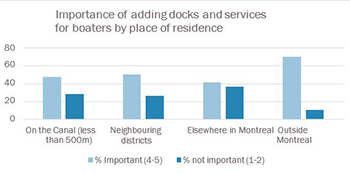

Participant places of residences also had an impact on the level of importance attributed to the proposal to design improvements and programming for each sector of the canal, which is much more important for participants living nearby (70%) and living outside Montreal (75%) than for Montrealers who do not reside near the site (50%).
In conclusion, it appears that for the majority of respondents, 60% of whom live in the vicinity of the site, the priorities for the canal should be improving the canal's existing service offering rather than adding new infrastructure or services, which are perceived as being intended for visitors and recreational boaters, as well as collaboration with the neighborhood.
3.4. Analysis of additional comments
All the comments received were analysed, including comments in the additional comments section of the questionnaires as well as those expressed in discussion groups during the meetings held on June 19. Several recurring themes emerged from this analysis.
Review the layout of the path and confirm its multifunctional role
In light of the comments received, there is a strong consensus that the cohabitation of cyclists and pedestrians is a major issue for the site. While several participants stressed the need to better integrate the path with the existing bicycle network, the primary importance remains making the path safe and confirming its multifunctional vocation (pedestrian and cyclist). Many comments stressed the importance of reviewing the layout of the path, as proposed by strategy No. 2 of the draft management plan. Suggestions for the redevelopment of the path include separating bicycle and pedestrian areas for safety reasons, particularly on bridges, expanding the path where possible and reviewing the signage to reduce conflicts of use. Many participants also stressed the importance of clearing snow from the path during the winter season so it can continue to serve as a link to the city centre.
"In your survey, I agreed with increasing the width of cycle paths. But it would also be very important for the safety and enjoyment of all to make sure to have sidewalks for pedestrians and joggers. It would be also important to clearly indicate and above all to differentiate the cycle and pedestrian paths." (Free translation)
"Dans votre sondage, j’étais d’accord avec le fait d’augmenter la largeur des pistes cyclables. Mais il serait également très important, pour la sécurité et le plaisir de tous, de s’assurer d’avoir des trottoirs pour les piétons et joggeurs. Il serait également important de bien indiquer et surtout différencier les pistes cyclables des chemins piétons." (Original citation)
Preserve the nature of the Canal
A number of participants commented on the importance of preserving the natural character of the canal and especially the green spaces found along the canal. Many who frequent the site to observe the fauna and flora consider it to be a large natural park. Several comments relate to the creation of green spaces and the planting of trees, especially fruit trees and shrubs. It is therefore hoped that the development of the canal and activities on site will not be at the expense of the site’s natural character. Moreover, many people highlighted the need to keep the atmosphere of the site calm and quiet to encourage its use as a green space for relaxation. The importance of not scheduling too many events at the site in order to maintain the balance between visitors, tourists, and local users was also emphasized at the June 19 discussion groups. In addition, improving the quality of water in the canal to be able to use it for swimming is also desired by certain users.
"It would be important to leave more room for green spaces. The city is increasingly being built up and the Canal is one of the few places where there are still green spaces." (Free translation)
"Il serait important de laisser une plus grande place aux espaces verts. La ville est de plus en plus construite et le canal est l’un des rares lieux où il y a encore des espaces verts." (Original citation)
"The Lachine Canal is, among other things, a delicate strip of wilderness in an urban area. This is its greatest asset. We see along the canal all sorts of wildlife: turtles, frogs, song birds, herons, kestrels, cormorants, ducks, red-wing blackbirds and more. Whatever your plans to develop the canal, you should, in my opinion, give the highest priority to the preservation and health of the ecosystem."
Maintain the public nature of the site
As proposed by strategy No. 3 of the draft management plan, many people consider it essential to maintain and highlight the public nature of the site through its development by preserving public access to the canal despite the development of residential projects in the area. In particular, several participants at the public meeting on June 19 indicated their disagreement with the construction of private docks on the canal, emphasizing that Parks Canada should only allow the construction of infrastructure that is accessible to all. In addition to improving access to the canal from the surrounding areas, for example by increasing the number of footbridges, many suggest avoiding site programming that is too focused on tourism and holding free and affordable activities for the local population.
"Any project must preserve the space as a PUBLIC space. There can be no question of selling parts to individuals, to allow the construction of private docks and other private structures. It is a space that belongs to all of us, we pay for it through our taxes, it must not be privatized." (Free translation)
"Tout projet doit préserver l’espace comme étant un espace PUBLIC. Il ne doit pas être question d’en vendre des parties à des particuliers, de permettre la construction de quais privés et autres structures privées. C’est un espace qui nous appartient à tous, on le paie par le biais de nos impôts, on ne doit pas le privatiser." (Original citation)
Increase collaboration with the community and partner organizations
A number of suggestions were made in regard to the integration of local organizations in the development of the site, including the following: working with Eco-quartier organisations to develop green spaces along the canal; involving the local historic and heritage associations to promote the heritage of the site; encouraging the development of local businesses and working more with the concertation tables. At the June 19 sessions, collaboration with the organizations and the local community was also highlighted as a way to ensure that the canal is developed with respect for the environment and its role as a public place. These comments reinforce the results of the questionnaire in relation to the importance attributed to the proposals regarding the involvement of communities in the development of the canal and the increase in benefits to the local communities resulting from strategy No. 3 of the draft management plan.
Improve development and maintenance
A large number of comments refer to various aspects of the maintenance of the site that should be improved, such as the number of waste baskets, the layout of picnic spaces, or the number of toilets or drinking fountains on the site. Several participants at the public meeting on June 19 stressed that improved maintenance and basic services would have a positive impact on their appreciation of the site. Furthermore, the proposal to improve basic services in all sectors of the canal was considered as "important" or "very important" by 78% of the respondents to the questionnaire. These results show that many participants use the site to take advantage of its assets, and that for them, improving the visitor experience, the goal of strategy No. 2 of the draft management plan, is achieved through the quality of site maintenance, street furniture and basic services.
4. Findings relating to the proposed management plan
In General, the high level of participation in the consultation activities reflects the importance that Montrealers and visitors attribute to the Lachine Canal as well as the interest they have in its development. The analysis of the questionnaire results and comments received confirm the relevance of the strategies proposed in the draft management plan for the canal. In particular, support for the draft management plan is expressed by the fact that 86% of respondents to the questionnaire "agree" or "completely agree" with the proposed vision for the Lachine Canal of tomorrow. This section presents an analysis of the evaluation of the management plan’s strategies.
4.1. Strategy 1: make the lachine canal a montreal emblem
Responses to the questionnaire concerning the objectives for this first strategy show a significant share of respondent support. In particular, the objectives involving the Montreal creative community and the holding of public competitions to receive initiatives and urban development projects as well as to improve the condition and integrity of the Canal buildings and engineering works received rates of "important" and "very important" responses of 76% and 75%, respectively. In addition, consultation with urban planners and other development actors, another objective stemming from this strategy, was cited repeatedly both in the questionnaire comments as well as during the June 19 sessions as being important to the success of the implementation of the management plan.
4.2. Strategy 2: a renewed visitor experience
This strategy, which addresses a number of priority issues for a large number of site users, appears to be the most important strategy for respondents based on the questionnaire responses and the topics of discussion during the June 19 sessions. Three of the objectives arising from this strategy stand out as being "very important" for the participants according to the responses to the questionnaire, as is demonstrated by the high rates of "important" and "very important" responses:
- Establish partnerships for "four season" activities: 81 %
- Improve basic services in all sectors of the canal: 78 %
- Increase the width of the bike path and develop new sections and routes: 78 %.
In particular, numerous participants support the proposal to review the development of the multifunctional path in order to address the concerns expressed on this subject (see section 3.4 Comments collected).
The responses to the proposal to add docks and services for recreational boaters show that this use of the canal is particularly appreciated by visitors from outside Montreal.
These results demonstrate that this strategy helps meet the priorities of different site users ranging from residents nearby who use it daily to visitors with a more targeted use.
4.3. Strategy 3: an important group asset, a development vector for the communities
Strategy No. 3, whose goal is to assert the public nature of the site and increase the site’s positive impact, its integration in communities and community appropriation of it, also generated a high level of support from respondents. The desire to affirm the public nature of the site was also expressed at the June 19 sessions and in the questionnaire comments (see section 3.4 Comments collected). Also, the proposal to establish new links with the adjacent neighbourhoods, another objective of this strategy aiming to improve access to the canal, received a high level of support from the participants.
In addition, the objective of involving communities in the programming and the outreach of the canal was the second most important objective for respondents, with 80% of "important" and "very important". The support of participants for this strategy thus confirms the importance of dialogue with the community in guiding plan implementation.
4.4. Strategy 4: an exceptional window on history and innovation
Strategy No. 4 intends to make the canal a preferred site for enhancing the public's awareness of the expertise of Parks Canada and the vast network of heritage areas managed by the Agency through the deployment of interactive panels to welcome visitors and promote the canal. These objectives, including the enhanced awareness of Parks Canada's expertise and the deployment of interactive panels, appeared to draw less attention from respondents. The fact that 60% of respondents live within 500 m of the canal or in a nearby borough could have an influence on the importance attributed to the distribution of information on or promotion of the canal. Parks Canada must consider explaining further the relevance of this strategy for the neighbours of the site.
4.5. A targeted approach for the peel basin
The objective of making the Peel Basin a gathering place and service centre for the canal is not the most important proposal for respondents, with 62% of "very important" and "important" responses, and few comments on the subject. However, as an integral part of the vision for the future of the canal with which 86% of respondents "agree" or "completely agree", the renewal of the Peel Basin received significant support. Moreover, the proposed approach for the development of the basin, including the development of the site through partnerships and the creation of connections with nearby neighbourhoods, is validated by the support shown for strategy No. 3 (see section 4.3).
5. Conclusion and next steps
5.1. Conclusion
The activities held in person and online allowed many people from different backgrounds to participate in the consultation. A majority of consultation participants are quite familiar with the canal because they frequent it often or live nearby. The consultation has thus connected with an informed population that is well aware of the realities of the historic site.
It is immediately noted that there is a strong consensus on the vision proposed by Parks Canada on which the management plan is based. This support, though more nuanced, also expresses itself in relation to the different strategies proposed in the management plan.
The user-friendliness and safety of the multifunctional path remains a top-tier issue for those who participated in the consultation. A consensus also appears to emerge as to the importance of consolidating and strengthening the existing assets of the site.
The consultation also highlights varied expectations regarding the purpose of the site, as neighbouring residents desire an urban park while visitors are more drawn to the canal’s tourist attractions. Maintaining the balance between these two vocations remains crucial to enjoyment of the site by a diversity of clients.
5.2. Next steps
The draft management plan will be finalised in light of the comments expressed in this consultation and will then be submitted to the Minister of Environment and Climate Change and Minister Responsible for Parks Canada, the Honourable Catherine McKenna, towards the end of 2017. Once approved, the new management plan for the Lachine Canal National Historic Site will be published on the Parks Canada website. Its implementation will be the subject of an ongoing dialogue to report on progress and adapt priorities over time.
- Date modified :
